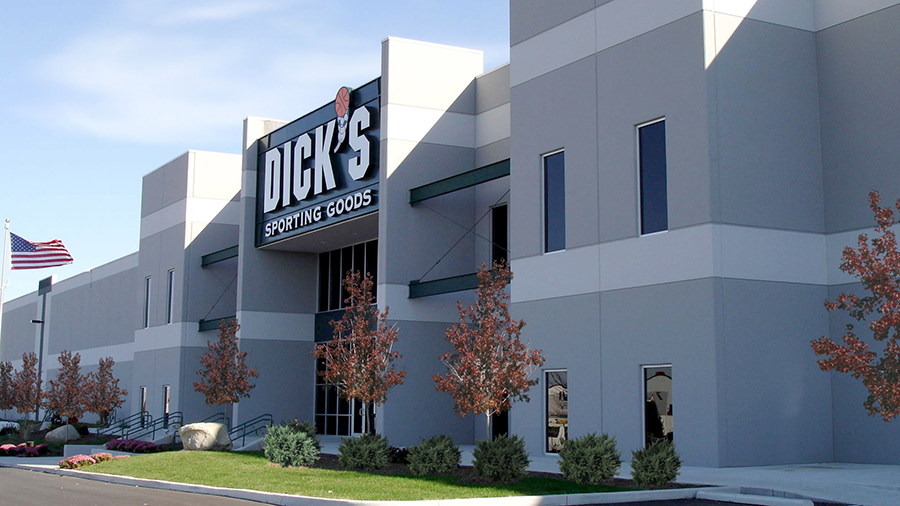Dick’s Sporting Goods this week followed Macy’s and other retailers in reducing its planned holiday hiring plans this year versus its 2022 plan. The downbeat hiring targets come amid forecasts of lowered seasonal hiring overall this year due to higher labor costs and expectations of softer holiday selling.
Dick’s plans to hire 8,600 seasonal teammates for the 2023 holiday season, fewer than the 2022 plan when the store count was roughly the same at 860 doors. Last year, the retailer said it would hire 9,000 temporary employees for the 2022 holiday season. No final hiring figures for the 2022 holiday season were provided.
Dick’s had five fewer Dick’s Sporting Goods stores at the end of the second quarter this year versus the comparable time last year but has five more specialty format stores than the year-ago period.
The holiday figure is much lower than in 2021 when Dick’s said it would hire up to 10,000 workers for the holidays, declaring the figure “the largest number of seasonal associates in the company’s history.”
Macy’s plans to recruit more than 38,000 full and part-time workers for positions at Macy’s, Bloomingdale’s and Bluemercury, as well as its distribution centers for the upcoming holiday season, down from about 41,000 targeted holiday hires and also below 2021’s plans of around 48,000 targeted hires.
A report last week from outplacement services firm Challenger, Gray & Christmas last week predicted U.S. retailers would hire the lowest number of seasonal workers this year since 2008 due in part to rising labor costs and interest rates.
“With inflation slowing, companies, particularly retailers, won’t be able to pass increased labor costs to the consumer as easily,” said Andrew Challenger, SVP of global outplacement at Challenger, Gray & Christmas. “This could lead to more cuts, rather than more added positions, as evidenced by the increase in job cuts in this sector.”
Challenger, Gray & Christmas’ analysis found retailers have announced 55,755 job cuts through August, up 524 percent from the 8,940 job cuts announced in the sector through August 2022.
So far this season, seasonal hiring announcements are slow to occur, the firm found. U.S.-based companies have announced just 178,500 seasonal hiring plans through September 19th, 2023, according to Challenger, Gray & Christmas tracking. By this point in 2022, employers had announced 258,201 seasonal hiring plans, up 36 percent from the 190,000 seasonal hiring plans announced by the same time in 2021 and down from 301,700 hiring plans companies announced at this point in 2020.
Challenger, Gray & Christmas expects retailers will add 410,000 seasonal positions this year. That’s down 19.5 percent from 509,300 holiday jobs created in 2022, as reported by the Bureau of Labor Statistics (BLS), as well as off 41.5 percent from 701,400 holiday hires in 2021.
Among the few other retailers announcing hiring plans so far, Target plans 100,000 holiday hires, the same target as the last two years. 1-800-Flowers.com plans to hire 8,000 this holiday, in line with hiring the previous three years.
UPS announced Tuesday plans to hire more than 100,000 seasonal employees to cope with the 2023 holiday rush, in line with hiring the previous three years despite a recent high in wages.
One outlier is expected to be Amazon, which plans to hire 250,000 full-time and part-time seasonal workers for its stores as well as for seasonal fulfillment center and transportation roles nationwide, up from 150,000 targeted hires in the 2022 holiday season. Amazon’s hiring jump comes as it has opened over 50 new fulfillment centers, delivery stations, and same-day delivery sites in the U.S. this year.
The expected slower hiring pace overall comes as a number of tepid holiday forecasts have arrived in recent weeks as retailers face headwinds ranging from inflationary pressures to higher interest rates, climbing credit-card debt and reduced pandemic-era savings. Deloitte forecast holiday sales in the U.S. will grow at their slowest pace in five years.
Challenger said, “Seasonal employers have a few issues to grapple with in the coming months. One is the cost of labor limiting the desire to add workers. Another is whether consumers continue to spend at the same clip. Another is one that has been fairly constant since the pandemic: can they attract workers?”
















